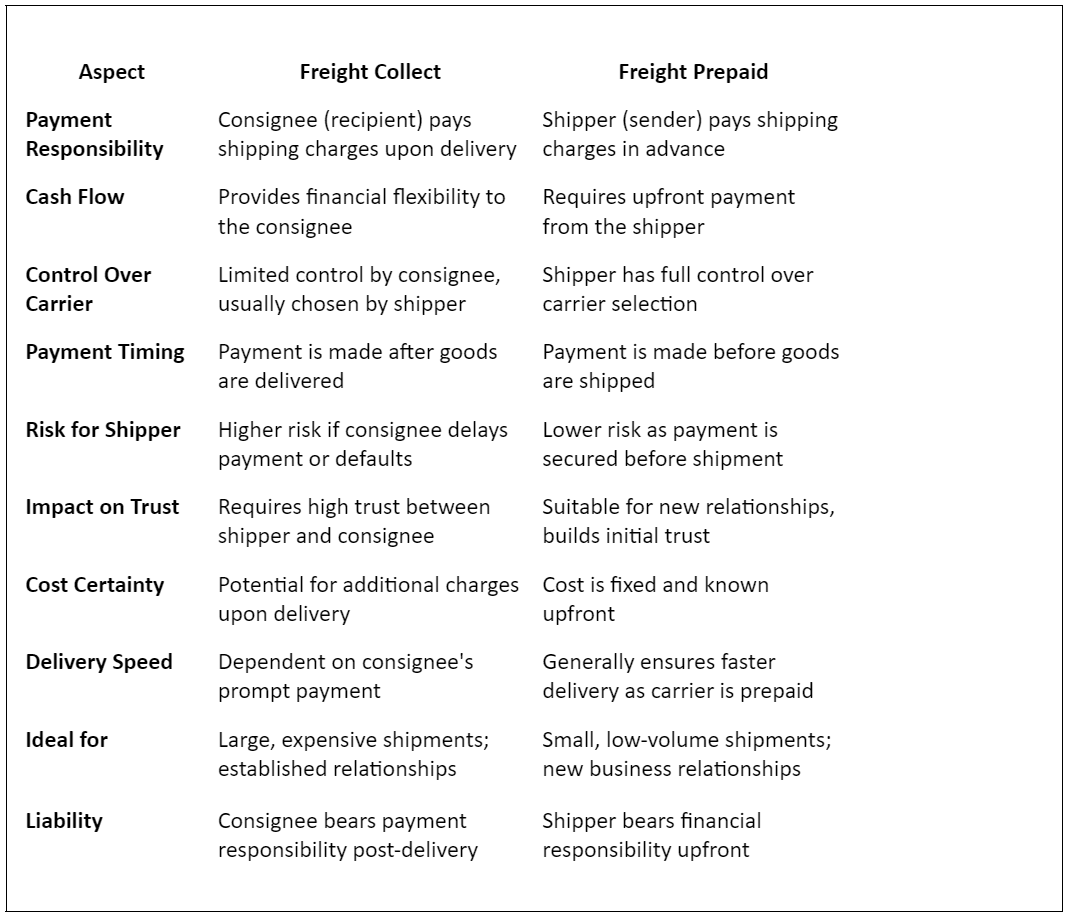
When it comes to international shipping, understanding the logistics process and financial aspects is crucial. A key element in shipping arrangements is determining who is responsible for paying the freight charges. This is where the terms “freight prepaid” and “freight collect” become important. Freight prepaid means the shipper pays the freight charges upfront, taking on the responsibility until the goods reach their destination. In contrast, freight collect means the consignee (the receiver) is responsible for the freight charges upon delivery.
Knowing the difference between these two terms helps businesses make informed decisions and manage their shipping costs more effectively. Understanding whether freight will be prepaid or collected can impact cash flow, budgeting, and the overall efficiency of your global trade operations. By clarifying these terms, businesses can ensure smoother transactions and avoid misunderstandings in international shipping.
Freight collect is a shipping arrangement where the consignee, or recipient of the goods, is responsible for paying the shipping charges upon delivery. In this setup, the consignee must settle the freight charges directly with the carrier or shipping agent. This arrangement is typically indicated on shipping documents as ‘freight collect.’
Understanding the advantages and disadvantages of freight collect can help businesses decide if this shipping method aligns with their needs. Here are the key pros and cons:
Pros of Freight Collect
Freight prepaid, also known as prepaid freight, is a shipping arrangement where the shipper (the seller or sender of goods) pays the shipping charges in advance. The shipper includes these freight charges in the overall cost of the goods and arranges for a carrier to transport the goods to the consignee (the recipient) without any additional payment required upon delivery. This arrangement is usually indicated on shipping documents as ‘freight prepaid.’
Understanding the advantages and disadvantages of freight prepaid can help businesses determine if this shipping method suits their operational and financial strategies. Here are the key pros and cons:
Cash Flow Disadvantage
Detailed Insights
Here’s a difference between freight collect and freight prepaid for your better understanding:

This table provides a clear comparison of the key features, benefits, and drawbacks of both freight collect and freight prepaid shipping arrangements.
Still struggling to decide between freight collect and freight prepaid? Here’s a detailed look at the situations and types of businesses best suited to each payment term.
Freight collect is often ideal for businesses that need flexibility in coordinating deliveries and managing extra fees, or where delayed payments are necessary for organizational or financial reasons. However, this method requires a higher degree of trust between the shipper and the consignee since there is more financial risk involved for the shipper if something goes wrong.
Example:
Imagine a shipper is sending a large, expensive shipment of rubber ducks to a trustworthy but small franchise of home goods stores. In this case, freight collect balances the shipper’s need for payment security with the small business’s financial ability to handle the shipment costs after delivery. This arrangement allows the small franchise to manage its cash flow more effectively while maintaining a good relationship with the shipper.
Freight prepaid is more suitable for shipments unlikely to incur additional charges, simplifying the payment process through a single transaction. It is often preferred by shippers handling lower volume shipments or when dealing with consignees they haven’t yet established a trust-based relationship with.
Example:
Consider a shipper sending three boxes of balloons to a new party supply store startup. Using freight prepaid in this situation helps build trust between the shipper and the consignee, particularly if the startup does not have consistent cash flow. By covering shipping costs upfront, the shipper ensures that the process is smooth and straightforward, which can be beneficial in establishing a good initial business relationship.
Freight collect and freight prepaid are key shipping arrangements with distinct benefits and drawbacks. Freight collect offers financial flexibility and negotiating power for consignees but requires trust and can cause delays. Freight prepaid ensures cost certainty and expedited delivery but demands upfront payment and higher liability for shippers. Choosing the right option depends on your business’s cash flow, relationship with partners, and shipment needs, ensuring smooth and efficient global trade operations.